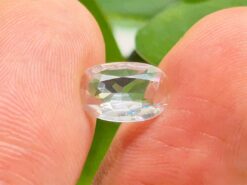Tenebrescent scapolite

Tenebrescent scapolite was first found in Badakshan province of Afghanistan in 2005.
Buy natural scapolite in our shop
Tenebrescent scapolite meaning
We found this unique colorless material near the hackmanite deposits. It changes to an aquamarine color when exposed to long waves or short waves UV light. This change of color is depending upon the time it has exposed to ultra violet light. This change of color is not permanent .
It faded gradually almost in 30 seconds. Depending the lighting condition.
Under tungsten light, tenebrescent scapolite faded its color very quickly. But in fluorescent light, the change in color is slowly.
Scapolite crystal
The scapolites are a group of rock-forming silicate minerals composed of aluminium, calcium, and sodium silicate with chlorine, also carbonate and sulfate. The two endmembers are meionite (Ca4Al6Si6O24CO3) and also marialite (Na4Al3Si9O24Cl). Silvialite (Ca,Na)4Al6Si6O24(SO4,CO3) is also a recognized member of the group.
Properties
The group is an isomorphous mixture of the meionite and also marialite endmembers. The tetragonal crystals are hemihedral with parallel faces, like scheelite. And at times of considerable size. They are distinct and usually have the form of square columns.
Furthermore, some cleavages parallel to the prism-faces. Crystals are usually white or also greyish-white and opaque. We found meionite as colorless glassy crystals in the limestone blocks of Monte Somma, Vesuvius. The hardness is 5 – 6. Also the specific gravity varies with the chemical composition between 2.7 (meionite) and 2.5 (marialite).
Natural scapolites are especially liable to alteration by weathering processes. With the development of mica, also kaolin, etc. Because of the usual opacity of the crystals. Owing to this alteration. and also to the variations in composition.
Numerous varieties have been distinguished by special names. Scapolite is commonly a mineral of metamorphic origin. It occurs usually in crystalline marbles. But also with pyroxene in schists and gneisses. The long slender prisms abundant in the crystalline marbles.
Furthermore, schists in the Pyrenees are known as dipyre or also couzeranite. Large crystals of common scapolite (wernerite) are found in the apatite deposits. In the neighborhood of Bamble near Brevik in Norway. It finally results from the alteration of the plagioclase of a gabbro.
Tenebrescent scapolite from Pakistan
Natural scapolite for sale in our gem shop
We make custom made scapolite jewelry as engagement rings, necklaces, stud earrings, bracelets, pendants… Please contact us for a quote.






